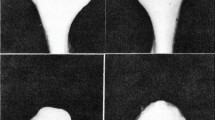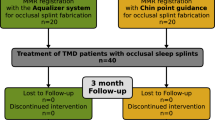Abstract
Questions:
What proportion of patients undergoing orthognathic treatment to correct dentofacial deformities also have temporomandibular joint disorders (TMD)?
What proportion of orthognathic patients who do not have signs or symptoms of TMD preoperatively develop TMD signs or symptoms postsurgery?
In individuals who have signs or symptoms of TMD preoperatively, how do these signs or symptoms change after treatment?
Data sources
Medline, bibliographies and reference lists of identified publications and reviews, and personal communications with experts and specialists.
Study selection
Randomised controlled trials (RCT), cohort studies and case-control studies were included if participants (of age 14 years or over) received orthognathic treatment. Studies were excluded if participants had either craniofacial syndromes or cleft lip or palate; a history of facial fractures from trauma; were undergoing orthognathic surgery purely to correct TMD; or orthognathic treatment and concomitant joint disc surgery; or, finally, if they were animal studies.
Data extraction and synthesis
Data extraction was conducted independently by two reviewers, with discrepancies discussed until agreement was reached. A quality-assessment scale was constructed specifically for this study with sections for selection, performance, measurement and outcome, and attrition. A narrative synthesis is presented as meta-analysis was not either feasible or appropriate. Meta-analyses were carried out on the 12 studies that used the Helkimo index to classify TMD in patients at presurgery and post surgery.
Results
Pain decreased after surgery for both self-reported symptoms and clinically diagnosed pain on palpation. However, postsurgical results were more varied for joint sounds. The percentage of patients with clicking had a tendency to decrease post surgery, but improvements in crepitus were questionable. The results from all meta-analyses in this review were subject to considerable statistical heterogeneity, and it was not possible to draw strong inferences relating to the percentage of orthognathic surgery patients with TMD with any degree of certainty.
Conclusions
Although orthognathic surgery should not be advocated solely for treating TMD, patients having orthognathic treatment for correction of their dentofacial deformities and who are also suffering from TMD appear more likely to see improvement in their signs and symptoms than deterioration.
Similar content being viewed by others
Commentary
The relation of TMD to orthodontics has been much debated and is a controversial topic at best. To define a further correlation between craniofacial skeletal deformity, correction and either alleviation or initiation and exacerbation of TMD is a challenging task. The 2-part systematic review has immense value at circumnavigating this controversial field with challenges at each step. There is an absolute lack of a defined scale for evaluating and quantifying TMD and this is evident in the 53 studies which meet the well-thought-of stringent inclusion criteria set by the authors for the review. The wide panoply of clinical presentations and the variety of surgical procedures performed leads to a lack of homogeneity of outcomes and therefore the apparent difficulty in carrying out a quantitative statistical analysis. The narrative analysis lays the foundation of the review with an interesting but well-defined set of questions which can now be answered by the narrative review and a selected meta-analysis where possible. What percentage of patients with skeletal deformity undergoing orthognathic correction present with TMD symptoms, does the surgical correction initiate signs and symptoms of TMD, are existing signs and symptoms of TMD alleviated or exacerbated by the surgical intervention? The questions are clearly of immense value to both student and clinician. Do we have some answers?
The authors have clearly surmised that a meta-analysis needs sufficient homogeneity to arrive at conclusions. The selection of 12 studies using the Helkimo index is the logical starting point. The findings from the meta-analysis do not permit strong conclusions because of the heterogeneity of the data. There are potential sources of bias which are discernable if one examines the charts prepared by the authors. This is well reflected by the pooled estimate of preoperative TMD as 74% with a wide 95% CI which in itself reflects the lack of precision. The percentage of skeletal Class 2 patients with TMD is again a wide CI of 95 % and the point estimate for a postsurgical change in TMD patients suggests a non-statistically significant 16% increase in TMD. In cases of VME treated with maxillary impactions the postsurgical incidence of TMD is fairly high at 68% and this could well be associated with mandibular autorotation, change in condylar position or consequence thereof.
Deriving conclusions from this commendable work is akin to fuzzy logic where a multi-valued logic is derived from reasoning that is approximate but not precise. The complexity of unravelling the 2-part review and meta-analysis with a narrative structure and new quality assessment and methodological tools is confusing at first, but with a little cerebral effort a clarity of outcome begins to emerge. Patients with skeletal deformity and TMD undergoing orthognathic treatment are likely to see alleviation of their signs and symptoms rather than deterioration. While crepitus is not affected, clicking is likely to improve rather than deteriorate with surgery. While surgery will result in some restrictive effects on the mandible, there are no permanent effects, and patients can exercise a full range of function over a period of time. A copy of this publication is well recommended for the waiting room with the key features outlined for the reassurance of patients, but the need to pick up condylar resorption and risk factors prior to surgery is an outcome. There is absolutely no doubt in the conclusions of the authors that TMD researchers should use a standardised scale and set criteria to evaluate TMD. Homogeneity of outcome is critical for evidence-based analysis and yet instead of just crying oneself hoarse over the need for good quality and well structured studies, good definitive clinical outcomes are possible even in the face of heterogeneity and wide variation in methods of assessment of a controversial entity such as TMD. All in all the 2-part review is a crucial piece of work for students, researchers and clinicians.
Author information
Authors and Affiliations
Additional information
Address for correspondence: Salma Al-Riyami, Orthodontic Unit, UCL Eastman Dental Institute, 256 Grays Inn Rd, London WC1X 8LD, UK. E-mail: s.alriyami@eastman.ucl.ac.uk
Al-Riyami S, Cunningham SJ, Moles DR. Orthognathic treatment and temporomandibular disorders: a systematic review. Part 2. Signs and symptoms and meta-analyses. Am J Orthod Dentofacial Orthop 2009; 136: 626.e1–16.
Rights and permissions
About this article
Cite this article
Kalha, A. Orthognathic treatment and temporomandibular disorders — part 2. Evid Based Dent 11, 84–85 (2010). https://doi.org/10.1038/sj.ebd.6400741
Published:
Issue Date:
DOI: https://doi.org/10.1038/sj.ebd.6400741



